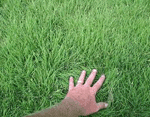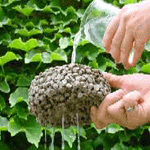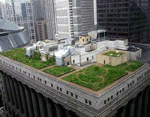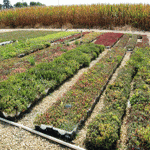One of the most prevalent topics during the construction of the Green & Main Pilot Project has been our plans for stormwater management. What will be most effective in dealing with rain water and snowmelt (sometimes simultaneously) at the site? How will we design the vegetative roof, the landscaping and paving materials in order to manage the amount of stormwater run-off?
Stormwater Run-off. What’s the Big Deal?
In an undeveloped site such as a forest, stormwater is off-set by the processes of infiltration into natural surfaces, as well as from evaporation. Essentially, when land is left in its natural state, the majority of rainfall soaks into the ground, flows slowly underground, is filtered by natural processes, and eventually feeds streams, lakes and underground aquifers.

Buffalo grass is a short grass with a deep root structure. It is low maintenance requiring minimal mowing and is a water-conserving grass perfect for drought control.
According to the EPA, in this type of natural environment, less than 1% of stormwater leaves the site in the form of runoff.
To begin, stormwater run-off is what occurs when rain or snowmelt flows over land, or other impervious surfaces, and is not absorbed into the ground. As the run-off flows over the various surfaces, such as paved streets, parking lots and building rooftops, it accumulates debris, chemicals, sediment or other pollutants that adversely affect the quality of the run-off water if it remains untreated. As much as 20-30% of stormwater can run off a developed site if there are no steps taken to direct or gather it.
So what’s the big deal? When stormwater run-off is not addressed, it can cause dramatic effects in the functioning and water quality of a planned watershed. As run-off travels overland, it can erode soils, change stream patterns and cause flooding. In addition to those mentioned above, run-off can also pick up additional pollutants such as sediments, toxic metal particles, pesticides and fertilizers, oil and grease, pathogens, excess nutrients and trash. Polluted run-off, if not diverted, has the potential to end up in publicly utilized waterways.
OK, So it is a Big Deal! Now What Do We Do?
Since the primary cause of stormwater run-off is increased impervious surfaces, a first step solution is the sustainable site design which minimizes impervious surfaces. The second step is to manage the stormwater so that as little of it leaves the site as possible.
When it comes to the pavement – sidewalks, driveways, parking lots – there are essentially two ways to make these impervious surfaces more water absorbent: either by using pervious concrete or incorporating permeable pavers.
Pervious concrete is a type of concrete that is highly porous, allowing water to pass directly through the concrete into the ground, thereby reducing run-off from a site. It also helps to replenish groundwater and helps reduce pollutants in run-off. According to concrete manufacturers, pervious concrete allows as much as eight gallons of water per minute to pass through each square foot.
Permeable paving describes materials and techniques that allow the movement of water and air around the paving material. All permeable paving materials have wide joints or openings filled with grass or gravel, allowing stormwater to percolate and infiltrate through areas that would traditionally be impervious to the soil below.
Explains Green & Main’s Chaden Halfhill, “The Green & Main building site in Sherman Hill includes permeable pavers incorporated into our north side parking area. This will allow a much larger percentage of the site’s stormwater to be absorbed into the ground.“
“In addition, we are incorporating a rain water retention basin behind the parking area. The water from that basin overflows into a ‘bio-swale’,” continues Halfhill. “A bio-swale is basically a ground indentation that moves water to a garden or landscaped area. The bio-swale also incorporates native plants with root systems that absorb the water.”
Water Efficient Landscaping
Stormwater management and landscape design go hand-in-hand. Again, the goal is to recreate what happens organically in nature. This means creating an environmentally functional landscape that mimics natural watershed functions.
Zach Heitzman of Green Bean Landscape in Ankeny, specializes in creating high quality landscapes with long-term sustainability and functionality. He is the landscape designer for the Green & Main Pilot Project. “For this site in Sherman Hill, we are using grasses and landscape plantings to replicate the native Iowa landscape,” states Heitzman. “The lawn will primarily be made up of buffalo grass which is very water efficient and requires very little work to maintain. It has a deep root structure and holds rain water very well.”
“For more ornamental landscaping, we’ll include little bluestem, switch grass and then pale coneflower, or Echinacea,” continues Heitzman. “Each of these plant species is native to Iowa and will thrive here while supporting the stormwater management objectives on site.”
Landscaping with plants native to an area helps ensure the maximum benefits are gleaned. As they are well-adapted to local environmental conditions, they maintain or improve soil fertility, reduce erosion and often require less fertilizer and pesticides than many other plants need.
A green, or vegetative, roof is vegetation growing on a contained roof space. During rainstorms, green roofs act as a sponge by absorbing much of the water that would otherwise run off. Researchers estimate that three to five inches of soil, or growing medium, absorbs 75% of rain storms that are ½ inch of accumulation or less. Green roofs also filter pollution from rainwater. This beneficial process increases over time as rooftop plants and root systems grow and mature.
“The green roof is one of our key stormwater management strategies,” states Halfhill. “The Green & Main roof will infiltrate water, saturating it, so less is shed from the roof. We also are using different roof levels, so water is dispelled as it progresses down.”
Green & Main’s green roof will be planted on October 4th by Rooftop Sedums of Davenport, Iowa. Their experience shows that up to 90% of stormwater can be conserved annually by incorporating a green roof.
Teresa Nelson of Rooftop Sedums explains the type of plant species best suited for the Green & Main roof. “When we are looking at an Iowa climate, a green roof solution must be able to withstand harsh weather conditions along with extreme temperature fluctuations,” states Nelson. “In addition, an Iowa roof will have to tolerate the weight of snow and the green roof soil, so a lightweight and shallow soil is also important. For these reasons, we are using varieties of sedum to vegetate the Green & Main roof. Sedum is a mountain ground cover plant, so it is hardy, has a shallow root system, drains well and controls erosion. Mountain plants thrive in these types of environments and they are drought resistant.”
According to Nelson, 90% of green roofs are planted with sedum. “For the Green & Main roof we will be using over 50 sedum varieties so it will be a very vibrant patchwork of different colors and textures,” continued Nelson. “We will also sparingly use a few deciduous plants for accent.” For more about this, read Johanna Hoffman’s article from August 30, 2011, ‘Natural Beauty and Green Technology at Green & Main‘.
Green & Main Setting the Standard
“My hope is that the design of the Green & Mail building is helping people see and experience how stormwater management can move from building to landscaping to the sewer,” adds Halfhill. “I’m proud that you can stand in back of our lot and see how the water moves – how it’s arrested, harvested and infiltrated as it moves from rooftop to ground.”
Editor’s Note: Check out some tips on how you can incorporate stormwater management practices on your own residential property. This list includes some great ways to harvest the rain for other uses as well.
– Ann Wilde is a Des Moines marketing strategist and writer who also has a special interest in preserving and creating sustainable communities.














I really love that buffalo grass! It looks nice, feels soft, and is great for helping out the environment.